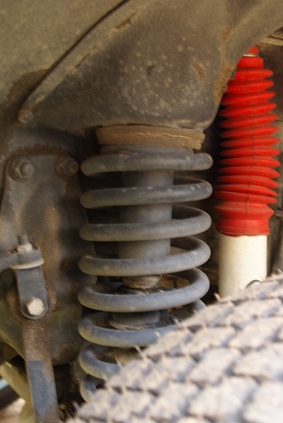
Replacing the shocks on a 2000 Chevy Silverado 1500 improves the suspension and operation of the truck and is recommended to be done every 30,000 to 50,000 miles (depending on use). The truck features shocks at all four corners of the vehicle. While you do not necessarily have to replace all four at the same time (although it will enhance the performance), you should always replace shocks in pairs along the same axle.
Apply the parking brake after parking the 1500 on a flat hard surface suitable for lifting the front axle.
Loosen the lug nuts on the two front tires a quarter-turn with the tire iron.
Raise the front axle, one side at a time, and place jack stands beneath the control arms. On two-wheel drive models, keep the jack stand away from the coil spring as the front shocks are housed inside.
Remove the loosened lug nuts and then remove the tires.
Remove the upper shock retaining nut using the ratchet and a socket. Remove the dampener and washer.
Remove the lower retaining bolt(s). The four-wheel drive model features a single lower bolt. Hold the head of the bolt with a hand wrench and then remove the nut on the other end of the bolt (a hammer and punch may be required to remove the bolt from its seat). The two-wheel driver model features two lower retaining bolts beneath the control arm. Remove those with the ratchet and socket.
Remove the shock absorber.
Place the lower washer and dampener on the top shaft of the replacement shock (these parts come with the replacement shocks) before installing the shock. Place the upper dampener and washer on the top shaft before replacing the retaining nut.
Replace the lower retaining bolt(s).
Torque the upper retaining nuts to 12-foot pounds and the two lower bolts to 24-foot pounds on the two-wheel drive models. For four-wheel drive models, torque the upper nut and lower nuts to 66-foot pounds. Be sure the lower bolt head is facing the rear of the truck.
Place a tire chock in front of one of the front tires.
Loosen the lug nuts on both rear tires one quarter-turn counterclockwise with the tire iron.
Raise the rear axle and support the truck on jack stands placed under the rear frame. Remove the lug nuts and tires.
Remove the upper retaining nut on the shock using the ratchet and socket. Remove the lower retaining nut with the ratchet and socket while holding the lower bolt head with a hand wrench. Use the hammer and punch if necessary to remove the lower bolt from its seat. Remove the shock.
Replace the shock by reversing the removal procedure. Torque the upper and lower retaining nuts to 70-foot pounds.